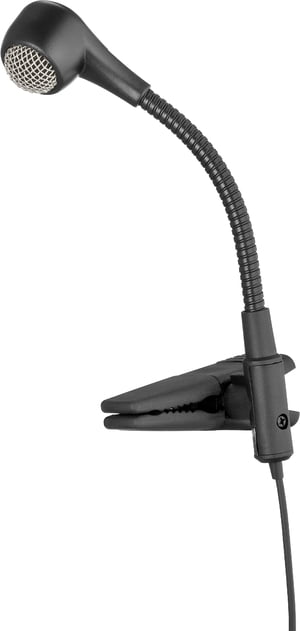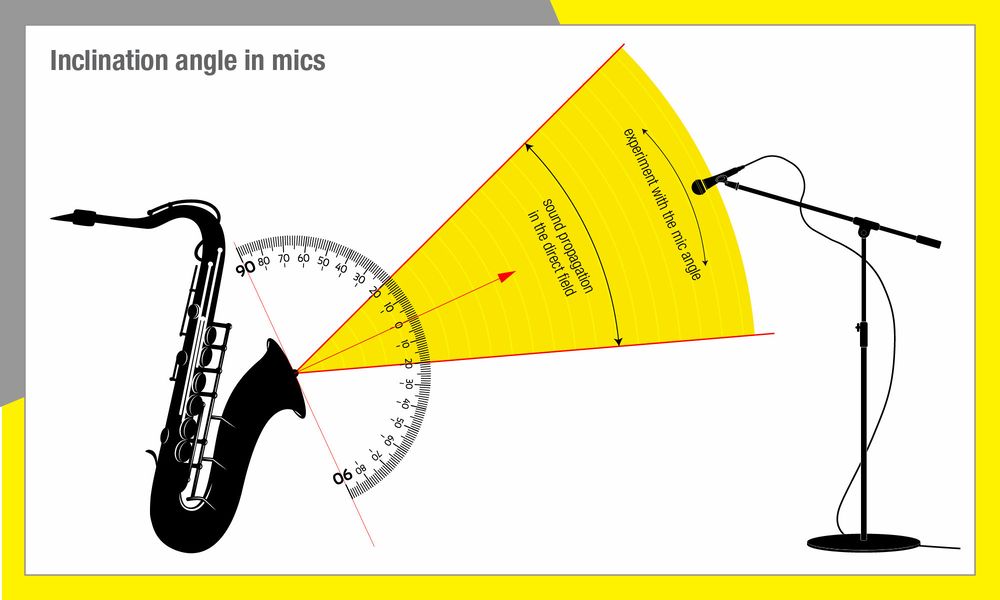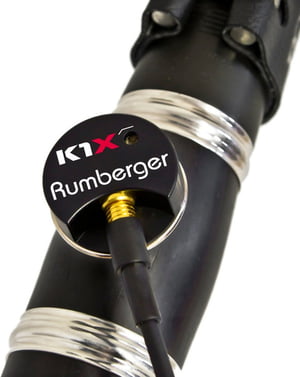3. Wood wind instruments
As we have just mentioned, one of wood wind instruments' main feature is their high inherent noise factor, which may actually be desirable to capture in a recording as they play a part in creating the respective instrument's characteristic sound. Deep and medium-range sound components (up to ca. 2,000 Hz) emerge sideways from the finger holes, to simplify a bit, while the higher-frequency components (from about 3,000 to 4,000 Hz) emerge from the bell. Thus, the timbre changes significantly according to the refraction angle. In direct recording, an angle of 45° to 60° to the tube with elongated instruments (clarinet, oboe, flute) is ideal. If you wish to achieve a naturally sounding recording, you should position your mic at some distance from the instrument. An ensemble would usually be recorded using a stereo pair arrangement (X/Y or A/B). The levels are lower than with brass wind instruments, so more sensitive mics may be used in direct recording.
The saxophone
Probably the most popular and most frequently used wood wind instrument, it has become indispensable in a variety of music genres.
The curved design of alto, tenor and baritone saxophones in itself means that the sound from the bell emerges sideways from the sound tube and thus they lend themselves to the use of clip-on mics on the bell.

Clip-on mic TG I52d by Beyerdynamic
They are particularly suitable for live use, as in this situation interference resonance (from other instruments or ambient noise) can be limited by using clip-ons. In combination with wireless transmission they allow musicians the greatest possible freedom of movement.But since they are not exactly a budget option, beginners in particularly will have to seriously consider whether buying one is worth the investment. A good set will run to about 600 EUR.
In studio recordings, large-diaphragm mics are also frequently used. You are free then to experiment with the distance from and the inclination angle towards the instrument as well as the position in the studio.

Inclination angle in mics
The flute
The flute offers a range of up to about 8,000 Hz. However, the sound refraction is highly frequency-dependent.
Acoustically speaking, the flute is di-polar, as sound emerges also from the mouthpiece. Unfortunately, this leads to obliteration in confined spaces, so that microphones should be equidistant from the mouthpiece and the end of the foot joint.
The frequencies around 3000 Hz are particularly complicated, as in a narrow range around this is where sound is also refracted backwards.

Applied Microphone Technologies recording system
On the other hand, technicians can be pleased that the instrument possesses relatively stable dynamics.
Vocal mics are frequently used in live recording, but bear in mind that these may over-accentuate the breathing noises which are particularly strong with flutes.
Very good specially designed recording systems for flutes are also available.
The clarinet
With the clarinet, too, the direction of refraction strongly depends on the frequency. Thanks to the instrument's position when played (while seated or standing), the medium to high frequencies are reflected depending on the floor covering.
Thus, we recommend never using a carpeted studio for clarinet recordings. A moderately resonant recording room with reflective floor covering (wood) provides a good combination of direct and diffuse sound components and thus renders the sound more natural.
Similar recording mics as with the saxophone are suitable. In principle you may also want to experiment with two mics, but this requires a very disciplined player, since the mic position you have determined as the best based on your experiments must, once attained, be maintained.
Live sessions can successfully be recorded both on high-quality low-feedback mics as well as on recording systems specifically designed for the clarinet, which allow for greater freedom of movement.

Rumberger clarinet recording system K1X
The bassoon
As previously mentioned, the bassoon is the wood wind instrument with the greatest frequency range even though its fundamental frequencies are located in the bass range. Thus an appropriate mic is required for recording, if you even need to, since bassoons are very rarely found in rock and pop music, and thus are more likely to be play a part in classical music performance and recording.
Since this is often done with stereo microphone arrangements employing various spot mics, good condenser or large-diaphragm mics are particularly useful. They should be positioned about 0.5m to 1m above the bell.
If, however, the bassoon plays solo parts or is even the sole instrument, it might be be worth experimenting with a second mic directed at the keys, which can then record the low mids (300-500 Hz) and help render the recording faithful to the typical bassoon sound (formant).






